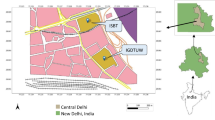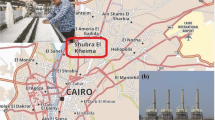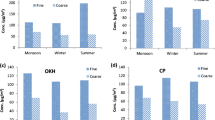Abstract
Santiago de Chile is a big city with huge air quality problems, being one of the most polluted cities in the world. This is aggravated during winter by the topography and meteorological conditions of the city. Although public policies have been developed to minimise the atmospheric aerosol pollution, there is a lack of adequate knowledge and poor characterisation of these aerosols (in its PM2.5 and PM10 fractions). In this study we sampled atmospheric particles during winter in two distinct areas of Santiago: downtown (Teatinos Street) and in a more residential area (Macul). Major (Si, Al, Fe, Ca and K) and some trace element (S, Cl, Ti, P, Cr, Cu and Zn) compositions were obtained by proton-induced X-ray emission (PIXE). Morphological, type and chemical characterisation was also performed using scanning electron microscopy (SEM) coupled with an energy dispersive X-ray microanalysis system (SEM–EDX). Besides the carbon particles, the contribution of which can be quite important in the atmospheric aerosol, especially in downtown, unambiguously lithogenic (i.e. of geological origin) particles and elements are the second highest contributors. Enrichment factor calculation, together with particle identification and element correlation allow the origin of some elements and particles to be traced, revealing anthropogenic origins for some of them that are specific to the Santiago area.







Similar content being viewed by others
References
Batonneau Y, Bremard C, Gengembre L, Laureyns J, Le Maguer A, Le Maguer D, Perdrix E, Sobanska S (2004) Speciation of PM10 sources of airborne nonferrous metals within the 3-km zone of lead/zinc smelters. Environ Sci Tech 38:5281–5289
Boix A, Jordan MM, Querol X, Sanfeliu T (2001) Characterization of total suspended particles around a power station in an urban coastal area in eastern Spain. Environ Geol 40:891–896
Castro LM, Pio CA, Harrison RM, Smith DJT (1999) Carbonaceous aerosol in urban and rural European atmospheres: estimation of secondary organic carbon concentrations. Atmos Environ 33:2771–2781
Celis JE, Morales JR, Zaror CA, Inzunza JC (2004) A study of the particulate matter PM10 composition in the atmosphere of Chillán, Chile. Chemosphere 54:541–550
Chucinta W, Hopke PK, Paatero P (2000) Investigation of sources of atmospheric aerosol at urban and suburban residential areas in Thailand by positive matrix factorization. Atmos Environ 34:3319–3329
Cong Z, Kang S, Liu X, Wang G (2007) Elemental composition of aerosol in the Nam Co region, Tibetan Plateau, during summer monsoon season. Atmos Environ 41:1180–1187
Dolgopolova A, Weiss DJ, Seltmann R, Kober B, Mason TFD, Coles B, Stanley CJ (2006) Use of isotope ratios to assess sources of Pb and Zn dispersed in the environment during mining and ore processing within the Orlovka–Spokoinoe mining site (Rusia). Appl Geochem 21:563–579
Gallardo L, Olivares G, Aguayo A, Langner J, Aarhus B, Engardt M, Gidhagen L (2000). Strengthening of the air quality information system. Working area 2: application of a regional-scale model over the central part of Chile. Regional dispersion of oxidised sulphur over central Chile using the HIRLAM-MATCH system. CONAMA, Santiago
Gallardo L, Olivares G, Langer J, Aarhus B (2002) Coastal lows and sulphur air pollution in central Chile. Atmos Environ 36:3829–3841
García-Huidobro T, Marshall FM, Bell JNB (2001) A risk assessment of potential agricultural losses due to ambient SO2 in central regions of Chile. Atmos Environ 35:4903–4915
Gramsch E, Ormeño I, Palma G, Cereceda-Balic F, Oyola P (2004) Use of the light absorption coefficient to monitor elemental carbon and PM2.5––example of Santiago de Chile. J Air Waste Manage Assoc 54:799–808
Grousset FE, Biscaye PE (2005) Tracing dust sources and transport patterns using Sr, Nd and Pb isotopes. Chem Geol 222:149–167
Isakson J, Oblad M, Lindgren ES, Fridell MD, Pacyna JM, Makinen M (1997) Perturbation of background aerosol at rural sites in the Nordic countries. Atmos Environ 31:3077–3086
Jorquera H (2002) Air quality at Santiago, Chile: a box modeling approach II. PM2.5, coarse and PM10 particulate matter fractions. Atmos Environ 36:331–344
Kasparian J, Frejafon E, Rambaldi P, Yu J, Vezin B, Wolf JP, Ritter P, Viscardi P (1998) Characterization of urban aerosols using SEM-microscopy, X-ray analysis and Lidar measurements. Atmos Environ 32:2957–2967
Koutrakis P, Sax SN, Sarnat JA, Coull B, Demokritou P, Oyola P, Garcia J, Gramsch E (2005) Analysis of PM10, PM2.5, and PM2.5–10 concentrations in Santiago, Chile, from 1989 to 2001. J Air Waste Manage Assoc 55:342–351
Krueger BJ, Grassian VH, Cowin JP, Laskin A (2004) Heterogeneous chemistry of individual mineral dust particles from different dust source regions: the importance of particle mineralogy. Atmos Environ 38:6253–6261
Leiva MA, González MR, Morales RGE, Belmar M, Morata D, Polvé M, Hasegawa S, Wakamatsu S (2005) Elemental and organic carbon ratios in aerosols at urban street canyon in Santiago downtown, Chile. IIII Jornadas Chilenas de Química y Física Ambiental Universidad de La Frontera, Temuco, Chile
Matzka J, Maher BA (1999) Magnetic biomonitoring of roadside tree leaves: identification of spatial and temporal variations vehicle-derived particulates. Atmos Environ 33:4565–4569
Miranda RM, Andrade MF (2005) Physicochemical characteristics of atmospheric aerosol during winter in the São Paulo Metropolitan area in Brazil. Atmos Environ 39:6188–6193
Miranda PA, Chesta MA, Cancino SA, Morales JR, Dinator MI, Wachter JA, Tenreiro C (2006) Recent IBA setup improvements in Chile. Nucl Instr Meth B 248:150–154
Morales JR, Dinator MI, Romo-Kröger C (1995) Caracterización del material particulado atmosférico en suspensión en Santiago de Chile. Parte VII determinación elemental mediante PIXE. Nucleotécnica 15:47–50
Morales RGE, Leiva MA (2006) Distribución y concentraciones críticas de material particulado en la ciudad de Santiago. In: RGE Morales (ed) Contaminación atmosférica urbana. Episodios críticos de contaminación ambiental en la ciudad de Santiago. Editorial Universitaria, Santiago, Chile, pp 107–172
Morel B, Yeh S, Cifuentes L (1999) Statistical distributions for air pollution applied to the study of the particulate problem in Santiago. Atmos Enviro 33:2575–2585
Moreno T, Gibbons W, Jones T, Richards R (2003) The geology of ambient aerosols: characterising urban and rural/coastal silicate PM10–2.5 and PM2.5 using high-volume cascade collection and scanning electron microscopy. Atmos Environ 37:4265–4276
Moreno T, Gibbons W, Jones T, Richards R (2004a) Geochemical and size variation in inhalable UK airborne particles: the limitations of mass measurements. J Geol Soc London 161:899–902
Moreno T, Jones TP, Richards RJ (2004b) Characterisation of aerosol particulate matter from urban and industrial environments: examples from Cardiff and Port Talbot, South Wales, UK. Sci Total Environ 334–335:337–346
Moreno T, Merolla L, Gibbons W, Greenwell L, Jones T, Richards R (2004c) Variations in the source, metal content and bioreactivity of technogenic aerosols: a case study from Port Talbot, Wales, UK. Sci Total Environ 333:59–73
Moreno T, Higueras P, Jones T, McDonald I, Gibbons W (2005) Size fraction in mercury-bearing airborne particles (HgPM10) at Almadén, Spain: implications for inhalation hazards around old mines. Atmos Environ 39:6409–6419
Muxworth AR, Matzka J, Petresen N (2001) Comparison of magnetic parameters of urban atmospheric particulate matter with pollution and meteorological data. Atmos Environ 35:4379–4386
Olivares G, Gallardo L, Langer J, Aarhus B (2002) Regional dispersion of oxidized sulfur in central Chile. Atmos Environ 36:3819–3828
Pérez P, Reyes J (2003) Prediction of maximum of 24-h average of PM10 concentrations 30 h in advance in Santiago, Chile. Atmos Environ 36:4555–4561
Rogge WF, Hildemann LM, Mazurek MA, Cass GR, Simoneit BRT (1993) Sources of fine organic aerosol 3. Road dust, tire debris, and organometallic brake lining dustroads as sources and sinks. Environ Sci Technol 27:1892–1904
Romero H, Ihl M, Rivera A, Zalazar P, Azocar P (1999) Rapid urban growth, land-use changes and air pollution in Santiago, Chile. Atmosph Environ 33:4039–4047
Rudnick RL, Gao S (2003) The composition of the continental crust. In: Rudnick RL, Holland HD, Turekian KK (eds) The crust vol 3, Treatise on geochemistry, Elsevier-Pergamon, Oxford, pp 1–64
Ruthlant J, Garreaud R (1995) Meteorological air pollution potential for Santiago, Chile: towards an objective episode forecasting. Environ Monit Assess 34:223–244
SERNAGEOMIN (2003) Mapa Geológico de Chile, scale 1:1.000.000, Santiago, Chile
Silva-Padilla MI (2005) Aplicación de la susceptibilidad magnética en material particulado atmosférico urbano en Santiago de Chile. Memoria de Titulo, Department of Geology, University of Chile, Chile, p 169
Silva C, Quiroz A (2003) Optimization of the atmospheric pollution monitoring network at Santiago de Chile. Atmos Environ 37:2337–2345
Stern CR (2004) Active Andean volcanism: its geologic and tectonic setting. Rev Geol Chile 31:161–206
Taylor SR, McLennan SM (1995) The geochemical evolution of the continental crust. Rev Geophys 33:241–265
Toscano G, Gambaro A, Moret I, Capodaglio G, Turetta C, Cescon P (2005) Trace metals in aerosol at Terra Nova Bay, Antarctica. J Environ Monit 7:1275–1280
Trier A (1997) Submicron particles in an urban atmosphere: a study of optical size distributions––I. Atmos Environ 36:909–914
Suzuki K (2006) Characterization of airborne particulates and associated trace metals deposited on tree bark by ICP–OES, ICP–MS, SEM–EDX and laser ablation ICP–MS. Atmos Environ 40:2626–2634
Yadav S, Rajamani V (2004) Geochemistry of aerosols of northwestern part of India adjoining the Thar Desert. Geochim Cosmochim Acta 68:1975–1988
Acknowledgments
This work was supported by the National Themes Program of the University of Chile (D.I. Project TNAC 06/03). The 12-month stay of M.P. in Santiago was supported by the IRD (French Agency devoted to Research and Development) and G. Herail, its representative in Chile. SEM analyses in Toulouse were covered by a CNRS grant to M.P. A.V. benefited from a fellowship provided by the EEC Alban program. Eduardo Medina is thanked for his assistance with the SEM facility in Antofagasta. The authors are grateful to Dominique Remy and Denis Legrand who made a great Fig. 1b, to René Garreaud for obtaining the meteorological data and to Natalia Muñoz and Victor Berrios for ICAP data. Suggestions and comments of anonymous reviewers notably improved the early version of the manuscript. J. Le Roux is also thanked for the English revision.
Author information
Authors and Affiliations
Corresponding author
Rights and permissions
About this article
Cite this article
Morata, D., Polvé, M., Valdés, A. et al. Characterisation of aerosol from Santiago, Chile: an integrated PIXE–SEM–EDX study. Environ Geol 56, 81–95 (2008). https://doi.org/10.1007/s00254-007-1141-8
Received:
Accepted:
Published:
Issue Date:
DOI: https://doi.org/10.1007/s00254-007-1141-8




